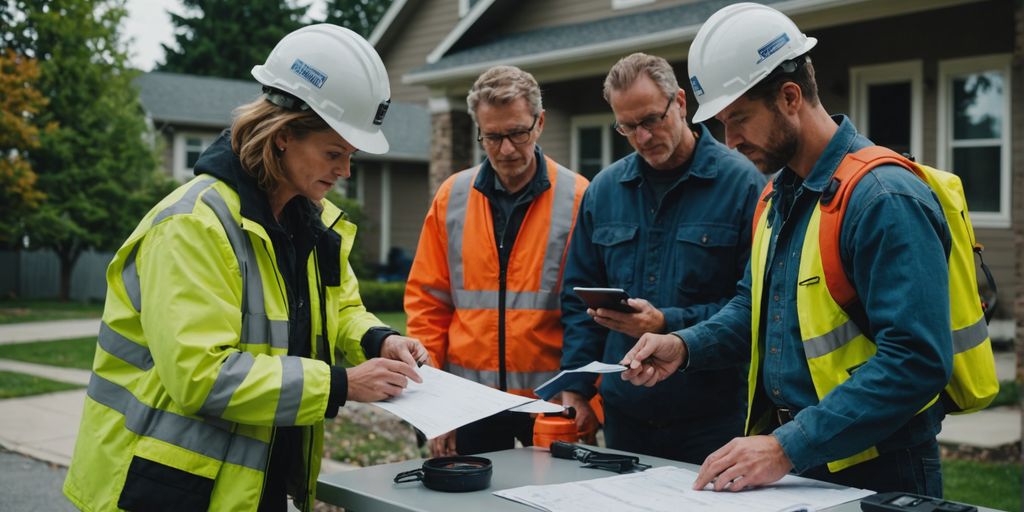Security emergencies can happen at any time and in many different ways. It’s important to understand the basics so we can be ready when they occur. This article will walk you through the key principles, the role of technology, and the steps to take during a security emergency. We’ll also look at real-life examples and discuss the role of the government and community in managing these situations.
Key Takeaways
- Knowing the core principles of security management helps in preparing for emergencies.
- Modern technology plays a crucial role in managing security emergencies effectively.
- A well-developed emergency action plan is essential for quick and efficient response.
- Understanding different types of security emergencies can help in better preparation and response.
- Community and government involvement are vital in managing and recovering from security emergencies.
Core Principles of Security Management
Security management is about keeping an organization’s assets safe, including its people, property, information, and reputation. In today’s world, threats can come from many places, like cyberattacks, terrorism, or even internal problems. Several core principles underline effective security management:
The Interconnection Between Security and Emergency Management
In today’s world, security and emergency management are closely linked. They work together to keep us safe and help us recover quickly when things go wrong. A strong security system can stop some emergencies from happening, while a good emergency plan can guide us when security fails.
Preventive Measures
Preventive measures are actions we take to stop bad things from happening. For example, a company might use security cameras and alarms to keep intruders out. These steps can stop problems before they start.
Emergency Response Plans
When something bad does happen, an emergency response plan helps us know what to do. This plan might include steps like calling for help, evacuating a building, or using first aid. It’s important to have a plan so everyone knows how to stay safe.
Recovery Strategies
After an emergency, recovery strategies help us get back to normal. This might include fixing damaged buildings, helping people who are hurt, and making sure the same problem doesn’t happen again. Recovery is a big part of staying strong and ready for the future.
Modern Technology in Security Emergencies
Modern technology has revolutionized how we handle security emergencies. Advanced surveillance systems and real-time data analytics are now essential tools in predicting and preventing potential threats. These technologies allow for continuous monitoring and quick response, ensuring a higher level of safety and preparedness.
Surveillance Systems
Surveillance systems have come a long way from simple cameras. Today, they include AI-driven technologies that can detect unusual activities and alert authorities in real-time. This proactive approach helps in mitigating risks before they escalate into emergencies.
Communication Tools
Effective communication is crucial during emergencies. Modern tools like satellite phones, mobile apps, and GPS tracking ensure that information flows seamlessly among responders and affected individuals. These tools enable quick coordination and efficient management of resources.
Data Analysis
Data analysis plays a significant role in understanding and managing security threats. By analyzing patterns and trends, authorities can predict potential risks and take preventive measures. This data-driven approach enhances the overall effectiveness of emergency management strategies.
The integration of cutting-edge technologies such as artificial intelligence and drones for surveillance marks emerging trends in emergency security services.
In conclusion, the role of modern technology in security emergencies cannot be overstated. From surveillance systems to communication tools and data analysis, these advancements provide a robust framework for managing and mitigating risks effectively.
Developing a Security Emergency Action Plan
Creating a security emergency action plan is essential for any organization, regardless of its size. This plan can save lives, money, and help mitigate legal issues. Here are the key steps to develop an effective plan:
Types of Security Emergencies
Security emergencies can come in many forms, each requiring specific responses to ensure safety and minimize damage. Understanding the different types of security emergencies is crucial for effective preparedness and response.
Steps to Take During a Security Emergency
When a security emergency happens, knowing what to do can save lives. Here are some key steps to follow:
Evacuation Procedures
Evacuate immediately if it’s safe. Remain calm and evacuate the area. Gather personal belongings only if it is safe to do so. Know the exit route from areas you’re regularly in and have a secondary exit if the first is blocked. Follow procedures for shutting off equipment and leave calmly. Remember–don’t stop to retrieve personal items.
Shelter-In-Place Guidelines
Sometimes, it’s safer to stay where you are. Close and lock all windows and doors. Turn off fans, heating, and air conditioning systems. Move to an interior room without windows, if possible. Stay informed by listening to emergency broadcasts or alerts.
Lockdown Measures
In certain situations, locking down is the best option. Lock all doors and windows. Turn off lights and stay out of sight. Silence your phone but keep it with you. Stay quiet and wait for further instructions from emergency personnel.
Simple and decisive actions taken in response to an evolving emergency can mean the difference between serious injury and staying safe.
Role of Emergency Management Professionals
Emergency management professionals play a crucial role in ensuring communities are prepared for various emergencies. They are not the front-line responders like police officers or firefighters but work behind the scenes to coordinate and plan effective responses to crises. Their responsibilities are diverse and essential for comprehensive disaster management.
Crisis Diagnosis
Emergency management professionals are responsible for identifying potential risks and hazards that could impact a community. This involves conducting thorough risk assessments and staying updated on emerging threats. By understanding these risks, they can develop strategies to mitigate them effectively.
Preparedness Training
One of the key roles of these professionals is to educate and train communities, organizations, and individuals on how to respond to emergencies. This includes developing and implementing training programs, conducting drills, and ensuring that everyone knows their role during a crisis. Advanced planning is essential for anticipating potential emergencies and instituting preventive measures.
Recovery Operations
After an emergency, the focus shifts to recovery. Emergency management professionals coordinate recovery efforts, ensuring that resources are allocated efficiently and that the community can return to normalcy as quickly as possible. This involves working with various agencies and stakeholders to rebuild and restore affected areas.
Effective disaster management begins with preparation. Security guards work with emergency planners and management teams to develop comprehensive disaster response plans.
The role of security services in disaster management is multifaceted, ranging from crowd control to traffic management and from supporting emergency responders to ensuring public safety. Emergency management specialists help plan emergency response programs and coordinate the response teams, making their role indispensable in managing crises.
Importance of Continuous Monitoring
Continuous monitoring is crucial for maintaining a secure environment. It involves the ongoing observation and analysis of security measures to ensure they are effective and up-to-date. This proactive approach helps in identifying potential threats before they escalate into serious issues.
Threat Detection
Continuous monitoring allows for the early detection of threats. By keeping an eye on critical business processes, such as financial reporting and compliance, organizations can quickly spot any irregularities. This real-time information helps in making informed decisions to mitigate risks.
Regular Reviews
Regular reviews of security measures are essential to adapt to new threats. By continuously assessing the security landscape, organizations can update their strategies and policies to address emerging risks. This ensures that the security measures remain effective over time.
Adaptive Strategies
Adaptive strategies are a key component of continuous monitoring. By analyzing data and trends, organizations can develop flexible plans that can be adjusted as new threats arise. This approach ensures that the organization is always prepared to handle any security emergency.
Case Studies of Security Emergencies
Corporate Breaches
In recent years, corporate breaches have become increasingly common, affecting businesses of all sizes. One notable example is the Ingersoll Rand case study, which highlights how the company enhanced security and emergency response. By integrating visitor and emergency management systems, Ingersoll Rand significantly boosted efficiency and safety.
Natural Disaster Responses
Each year, the Federal Emergency Management Agency (FEMA) helps hundreds of thousands of people recover after disasters. FEMA provides critical emergency services, ensuring that communities can rebuild and recover swiftly. Their efforts demonstrate the importance of having robust emergency response plans in place.
Public Safety Incidents
The University of Arkansas Police Department (UAPD) reviewed available technologies for command and control, officer safety, and emergency response. This case study showcases how modern technology can be leveraged to improve public safety and manage emergencies effectively.
Effective emergency management requires a combination of preparedness, quick response, and continuous improvement.
Cybersecurity Threats
Secureworks has a library of case studies that show how their cybersecurity platform helps customers prevent, detect, and respond to threats. These case studies underline the importance of having a strong cybersecurity strategy to protect against potential breaches.
Large-Scale Events
In another case study, a comprehensive security solution was provided for a large event, including crowd control, perimeter security, and emergency response teams. Despite the large crowd, the event was managed successfully, highlighting the importance of thorough planning and coordination.
The Role of Government in Security Emergencies
Policy Development
The federal government’s responsibilities for emergency response are established by statute and by executive orders issued by the president. These policies guide how different agencies should act during emergencies. Clear policies ensure everyone knows their role and can act quickly when needed.
Resource Allocation
The Department of Homeland Security was established in 2002, combining 22 different federal departments and agencies into a unified, integrated cabinet agency. This helps in pooling resources and ensuring they are available where needed most. The Federal Emergency Management Agency coordinates the federal government’s role in preparing for, preventing, mitigating the effects of, responding to, and recovering from all domestic disasters, whether natural or man-made.
Public Communication
Effective communication is crucial during emergencies. Governments must keep the public informed about what is happening and what they should do. This includes using various channels like TV, radio, and social media to reach as many people as possible. Building stronger communities involves planning, educating, and ensuring efficient recovery for disasters. Local governments play a crucial role in this aspect, especially in the face of climate change impacts.
Governments play a vital role in managing security emergencies by setting policies, allocating resources, and communicating with the public. Their actions can significantly impact the effectiveness of emergency responses and recovery efforts.
Community Involvement in Security Emergencies
Community involvement is crucial in managing security emergencies. Engaging the local community helps in building a resilient and prepared society. By fostering communication strategies, communities can share safety protocols and strategies, reducing opposition to essential security measures.
Challenges in Security Emergency Management
Security emergency management faces several persistent challenges that can complicate efforts to protect people and assets. These challenges require specialized skills, advanced training, and strategic planning to overcome effectively.
Conclusion
In today’s world, understanding security emergencies is more important than ever. From natural disasters to security breaches, being prepared can make a huge difference. By knowing the basics of risk assessment, planning, and monitoring, we can better protect ourselves and our communities. Remember, a good security plan not only helps prevent emergencies but also guides us when they happen. As threats change, our strategies must adapt too. Stay informed, stay prepared, and stay safe.


